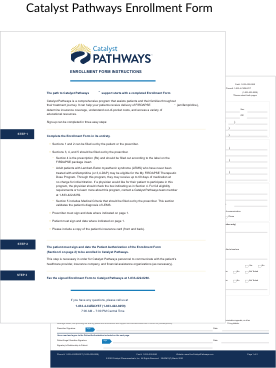FIRDAPSE ACCESS AND FINANCIAL SUPPORT
FIRDAPSE is available and affordable for virtually every patient with LEMS
Catalyst Pathways® programs have helped patients gain access to treatment and minimized their out-of-pocket costs for FIRDAPSE31
$2/month
Average monthly copay for patients enrolled in Catalyst Pathways31*
Catalyst Pathways offers your patients a world of personalized support
Catalyst Pathways provides intuitive programs and expert personnel to support patients with Lambert-Eaton myasthenic syndrome (LEMS) throughout their treatment journey.
ENROLL YOUR PATIENTS NOW IN CATALYST PATHWAYS!
There are 2 easy ways to secure all the benefits of Catalyst Pathways:
Download and complete the Enrollment Form.
Call 1-833-4-CATALYST
( 1-833-422-8259 ) to talk with a representative who can help you complete the Enrollment Form.
PROGRAMS THAT ENSURE THE ACCESSIBILITY AND AFFORDABILITY OF FIRDAPSE FOR YOUR PATIENTS
Our dedicated team of experts helps optimize your patients’ FIRDAPSE treatment experience
2 easy ways to enroll patients in Catalyst Pathways

- Complete the Enrollment Form at YourCatalystPathways.com
- Contact a FIRDAPSE Representative at 1-833-4-CATALYST (1-833-422-8259)